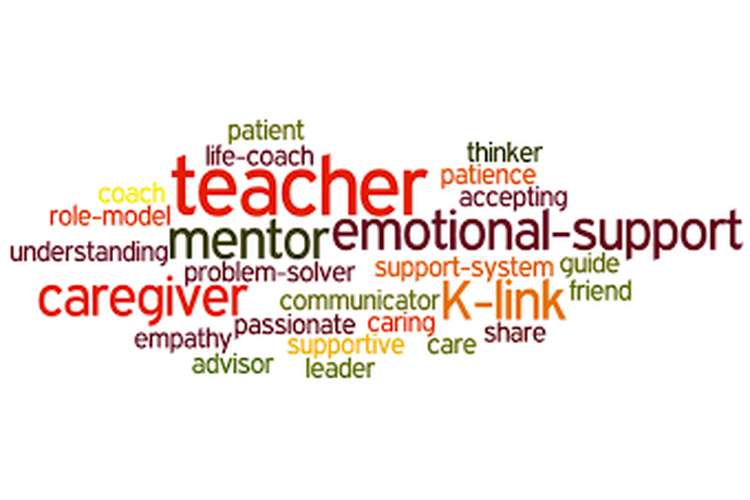Can teachers maintain the same relationships with students over Zoom?
Word web describes roles teachers play in students’ lives, something difficult to maintain through online learning.
Teachers have been trying numerous methods to maintain relationships with their students over Zoom, despite the challenges hindering them. With both students and teachers adjusting to the online learning environment, class connections have been established between both students and teachers. However, connections between those in the classroom have been altered, and forming relationships takes an entirely different form over Zoom.
This is especially challenging for the Freshman class. Teachers of the Freshman class have taken extra care to engage their students, helping them to establish connections with their peers in any way possible.
“Certainly try to make things more lighthearted,” Freshman Theology teacher Mr. Lantz said. “A lot more small talk and personal conversation. [I] try to create that personal connection where you would normally just be able to be in the same room with the person.”
The primary differences between in-person classes and Zoom classes are not only the deep connections formed between peers, but also the small interactions between teachers and students in class or during passing periods.
“It’s harder because it’s all of the tiny little things that just don’t happen,” Theology teacher Ms. Barry said. “It’s when you walk into the classroom; it’s that whole beginning of class and it’s that whole walking out of the classroom. There’s moments where they walk by you or you walk by them and you have these tiny interactions.”
Along with small interactions, teachers have been trying numerous different methods to engage their students as a whole, establishing a sense of community within a virtual classroom. These methods include small discussions before class, bonding activities in breakout rooms, and much more.
“I’ve watched other teachers’ classrooms and sat in on Zooms, so I saw one teacher who let students tell her how they’re doing in a private message on Zoom chat which I really like because it’s kind of intimidating to talk on Zoom when there are 30 people in the class,” Mr. Lantz said.
In addition to teachers creating new methods of connecting with their students, students also have the opportunity to take initiative and maintain relationships with their teachers. This can be in the form of small actions, such as staying after class to provide feedback or even simply speaking up during class.
“Asking questions during class is a really nice way to engage in class,” senior Savannah Fitts said. “Also talking during breakout rooms or getting to know teachers better by sometimes staying after the Zoom to give them advice…Especially with Environmental Science, Ms. Humm is new, and I’ll sometimes stay after and say, ‘I really like doing this, or I really like this project.’”
While small interactions hold great value, classes involving deep discussions between students find challenges when breaking barriers between students. Connecting through a screen proves especially difficult, as class discussions may require a strong sense of trust between students, something difficult to build virtually.
“I learned early in my teaching career that if you ask people to be vulnerable and do something that makes them raw, you have to support them,” Ms. Barry said. ”So anytime I give them an assignment that makes them be vulnerable or asks them to be vulnerable, I’m going to support them by reading it and responding to them, but I also want them to share with their partner…I tell them to build trust a little bit at a time, and trust as much as you can and a little bit more. That’s actually going so much better than I thought it would because I was worried about that over Zoom.”
While maintaining a strong sense of motivation for school can be difficult for students when learning virtually, teachers also may feel drained from the constrictions placed through online learning, hindering them from fully connecting with their students.
“It’s a lot more emotional energy from me,” Ms. Barry said. “I just have to be very obvious that I love you and I care about you and I want you guys to talk to each other, and I’m trying [to come] up with creative ways of doing [that] over Zoom.”

Scout Jacobs is a managing editor for the Jesuit Chronicles at Jesuit High School. As a senior in high school, this is her third year doing Journalism, and she loves to write. Journalism has been a primary passion of hers throughout highschool, and she hopes to continue this passion through college. Outside of school and writing, Scout enjoys reading, hanging out with friends, and listening to music. She is on the swim team at Jesuit, and has been swimming since she was a freshman. Born and raised in Portland, OR, Scout has an older brother who graduated Jesuit last year, who is now attending Seattle University. In her free time, she is usually watching a movie or spending time with her family at home or at fun destinations around Portland. Her favorite subject in school is English, and she has been taking French throughout her high school career in hopes of becoming fluent in the language. She loves the outdoors, and her favorite activity to do with friends is to go on a hike or go swimming. During the weekends and long breaks, Scout usually visits her family in Seattle, where most of her extended family lives. Both of her parents are architects, and she loves hearing about their work and the creativity they use to feel passionate about their work.



